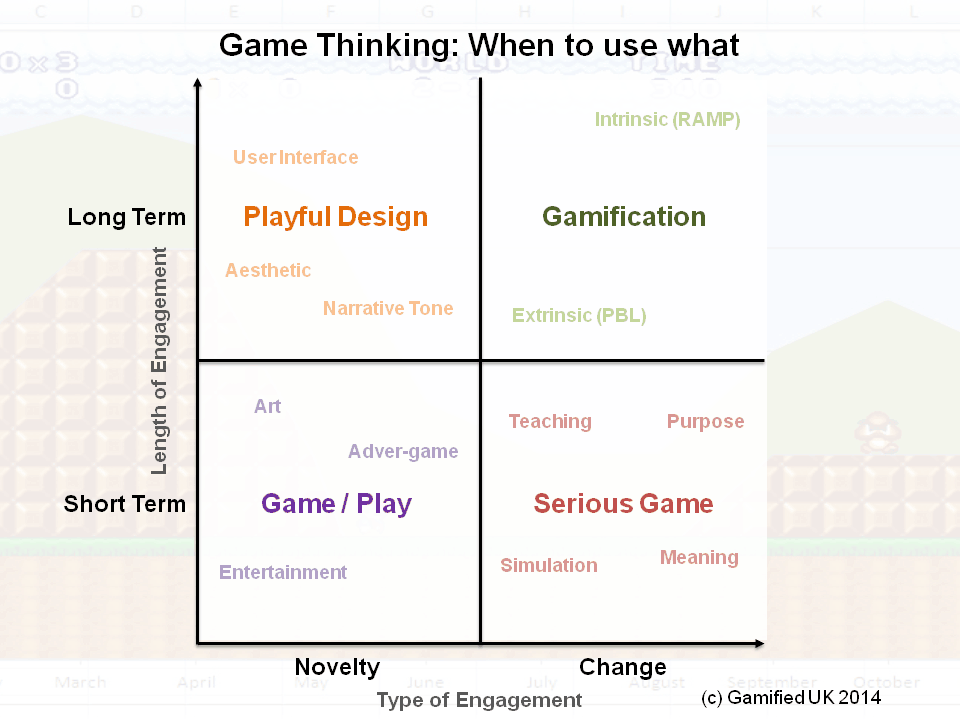Happy 2019. I thought this year I would go back to the beginning and reintroduce all of my previous work for a whole new generation! Sounds boring and a copout, I know. However, having not long released Even Ninja Monkeys Like to Play: Unicorn Edition, it seems like a good time to have a bit of a fresh look at things.
What is Gamification
So, starting at the beginning, let’s explore what gamification is, 8 years after I first discovered its existence!
The first thing to keep in mind is that gamification is not just about making games. In a true game, entertainment is the desired outcome of what the designer is building. In gamification, there is normally a defined business outcome, such as higher engagement rates. Entertainment is very rarely the core reason a business will want gamification in their product or service.
There are plenty of definitions out there, but currently, I am using the following to describe gamification from a business context.
The use of game design, game elements and play for non-entertainment purposes
I say business context because it is important to remember that when you are talking to clients, they are generally not interested in an academic discussion about the ins, outs and philosophies of gamification, they just want a quick answer about what it is, followed swiftly by how it is going to help them!
If we break down the definition, it gives more depth to what gamification really is to us and our clients.
Game design is the core of what we are doing most of the time. Working out what goes where and importantly why it goes there.
Game elements are those parts or lessons from games that we use in our designs. Goal setting, feedback, rewards, narratives, leaderboards, social interactions etc. These are often considered mechanics and dynamics (as well as aesthetics) but can include more. This will be discussed further in a future blog.
Play is something I am seeing more and more in good gamification, where designers are allowing for some freedom to explore and experiment outside of the “stricter” structural rules of the system. It is hugely important to include this as we move forward with gamification design. Put simply, play does not include system imposed / explicit rules on what a player does. It’s the difference between bouncing a ball off a wall for fun and bouncing it off the wall but only being able to use your left hand and scoring points for each catch. One has no system imposed rules, the other has. Again, play will be discussed in more depth another time as it can get a little philosophical, but there is loads more on the topic here – Games and Play Chapter.
Non-Entertainment purposes. As I said earlier, gamification is used to help achieve specific goals, very rarely would those goals be entertainment.
Game Based Solutions (GBS)
I mentioned this earlier and this will be explored in the next blog, but I wanted to introduce the concept here. Game Based Solutions is an umbrella term I am using to describe any solution to a problem that uses something related to games. This differs from gamification as it includes real games, which gamification does not. Under this umbrella, we have things like Serious Games, Simulations and Game Inspired design.
It is important to keep in mind that whilst a client may ask about gamification, they are not necessarily actually talking about pure gamification. Their problem may need more than pure gamification can offer, so when you hear people speaking about gamification, they are often talking about Game Bases Solutions.
Strategy Not Sticking Plaster
Gamification and Game Based Solutions should not be considered a sticking plaster (or band-aid) to fix and cover up broken processes. Adding a layer of gamification onto an already broken process or product will invariably make it worse. It may look good, but at best it is going to only provide very short-term improvements. People are not stupid, if you treat them as if they are, they will turn on you! That sounded less sinister in my head…
Gamification should be part of a strategy, either included in the initial design of a solution or as part of planned improvements.
Think of it like this. If you have bad rust on a car, you can do one of two things. You can paint over it and hide it, or you can remove the affected area and replace it with new, stronger metal. The first option may be quicker, easier and far less expensive, but the second will be far more effective and last far longer.
Key Learning Points:
- Gamification is not about making games.
- Gamification is one tool from a Game Based Solutions toolkit.
- Gamification will not fix a broken process.
- Gamification should be part of a strategy.
Similar Posts:
- No Blog Post – New Book
- Introduction to Gamification Part 2: Game Based Solutions
- How to Use Game Thinking


Also published on Medium.


45 thoughts on “Introduction to Gamification Part 1: What is Gamification?”